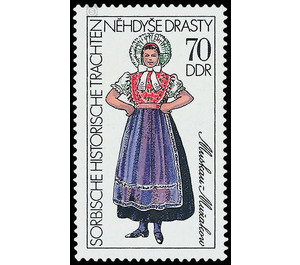Sorbian historical costumes - Germany / German Democratic Republic 1977 - 70 Pfennig
Theme: Art & Culture
| Country | Germany / German Democratic Republic |
| Issue Date | 1977 |
| Face Value | 70.00 |
| Color | multi-colored |
| Perforation | K 14 1/4 |
| Printing Type | Rotogravure 2 |
| Stamp Type | Postage stamp |
| Item Type | Stamp |
| Chronological Issue Number | 1956 |
| Chronological Chapter | GER-DDR |
| SID | 980881 |
| In 19 Wishlists | |
Sorbian Historical Costumes The Ministry of Posts and Telecommunications of the German Democratic Republic issues five multicolored special postage stamps with pictures of Sorbian historical women's costumes. Sorbian historical costumes Around the middle of the 19th century, all Sorbian girls and women of Lusatia wore folk costumes, while the men were already turning to fashionable clothing. Today, Sorbian folk costumes can only be found in four costal regions in the districts of Cottbus and Dresden, where they usually carry only older women. As early as 1968 festival costumes and 1972 dance costumes were displayed on special postage stamps from these areas. The present series is dedicated to the Sorbian-historical costumes, which, on a recent occasion in honor of the IX. Federal Congress of Domowina, the socialist national organization of the Sorbs, appears. These costumes, also known as truids, were created in the past for a variety of reasons. They have completely disappeared from the public today, and can only be found in chests or museums. Like the costumes that still live, they too bear witness to the wealth of ideas and creative power of the working people. 70-Pfennig-Wert- Costumes from Muskau This costal area included about 15 villages around Bad Muskau in the district of Weißwasser. The dancing and dancing costume of the girls is shown around 1890. The same barren soil conditions as in the Nochten area resulted in a poor living of the inhabitants. This bad economic situation was reflected in the design of the costumes. In addition to cloth and woolen fabrics, mainly cheap cotton fabrics and canvas were used for their production. Like the other Sorbian heathenesses, so too is the Muskauer's own color. Here, too, though not as much as in the neighboring areas, pieces of festive costumes were adorned and valorized by hole and white embroidery.


